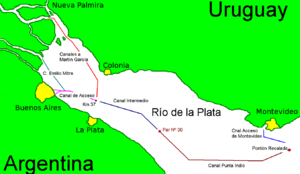Martín García canal dispute facts for kids
The Martín García Canal is a very important waterway shared by Uruguay and Argentina. It connects the River Plate (where Uruguay's ports are) to the Uruguay River. For over ten years, work to make this canal deeper, called dredging, has been stopped. This delay has made it hard for Uruguay to grow its ports and trade.
Why is the Canal Important?
The Martín García Canal is like a highway for ships. When a canal is dredged, it means the bottom is dug out to make it deeper. A deeper canal allows bigger ships to pass through. These larger ships can carry more goods, which helps countries trade more easily and makes their ports busier.
A Long-Standing Problem
Back in 2006, Argentina made the Mitre Canal deeper, reaching about 11 meters (36 feet). This allowed very large ships to use it. However, Argentina did not agree to make the Martín García Canal just as deep. If the Martín García Canal were also 11 meters deep, ships carrying more than 45,000 tons could use it.
Some people in Uruguay believe that groups connected to the ports in Buenos Aires and Rosario (in Argentina) don't want Uruguay's port of Nueva Palmira to become too successful. These Argentine ports are major centers for shipping things like soybeans. It is thought that these groups have worked to stop the Martín García Canal from being dredged deeper.
The Role of CARP
There is a special group called the Comisión Administradora del Río de la Plata (CARP). This group is in charge of managing the River Plate area. One of its jobs is to make sure important canals, like the Martín García Canal and the Mitre Canal, are regularly dredged. However, a disagreement between Uruguay and Argentina about pulp mills (factories that make paper pulp) made it even harder for them to agree on dredging the canal.
See also
- Pulp mill dispute
- 1973 Boundary Treaty between Uruguay and Argentina
 In Spanish: Canales a Martín García para niños
In Spanish: Canales a Martín García para niños


